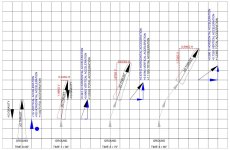I was not using any “Grav technology” assumptions. I was just reading a c.1960 technical report on Ballistic Missiles and Thrust Angle of attack and read about how the optimal angle for cruise set the vertical component of the thrust vector to just offset gravity to achieve maximum horizontal acceleration. That caused me to reapply basic Pythagorean algebra to good old Traveller vector movement.Your 2G air raft needs to use a declining amount of vertical thrust until it hits an orbital speed
your vertical component is (sin(45°)×2g)-GLocalat elevation the sin is roughly 0.7071, and thus the vertical is 1.4142-1 = 0.4142 G vertical at takeoff, and 1.4142-0.9= 0.5142 G vertical at LEO.
YOU do the math instead of me. Gravity is a vector downward at 1G at the surface of the earth (at launch). The Thrust/Weight ratio is 2, so the THRUST from the rocket exhaust is a Vector 2G out the back of the rocket, causing a 2G movement vector in the opposite direction.
CASE 1: The rocket launches straight up. 2G THRUST vertical up vector and 1G GRAVITY vertical down vector. What is the resulting vector?
I come up with 1G.
CASE 2: The rocket launches on an angle so that the Vertical component of the 2G thrust vector is 1G up and the total length of the thrust vector is 2G (just like a ballistic cruise missile). The Gravity vector is 1G downward. What is the HORIZONTAL COMPONENT of the 2G diagonal Thrust Vector? (the vertical component of the thrust vector offsets gravity so the craft moves horizontally.)
(Hint, according to Pythagoras, the sum of the squares of the vertical and horizontal sides is equal to the square of the angled hypotenuse.)
I come up with sqrt (3) G.
In case 1, the rocket accelerates 1G vertically and in case 2 the rocket accelerates sqrt (3)=1.73G horizontally.
Both cases will eventually reach Orbital Velocity (10 km/s). Case 2 will reach orbital velocity faster.
The observation is “straight up subtracting local gravity” (irrespective of 1G or 0.9G) is not the best model and Real Rockets only accelerate vertical (subtracting the full planetary gravity penalty) for the few seconds that it takes to clear the atmosphere (100 km?) … then they perform a “gravity roll” and accelerate horizontally at the “Case 2” rate for the majority of the launch.
[FYI: I think the launch angle is 30 degrees for 2G thrust to give 1G vertical and 1.73G horizontal.]
Last edited:

